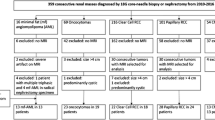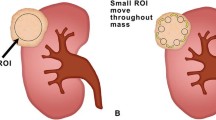Abstract
Purpose
To determine whether the frequency of intra-observer measurement discrepancies ≥5 mm for solid renal masses varies by renal mass characteristics and CT contrast phase.
Materials and methods
This HIPAA-compliant retrospective study was approved by our IRB. We selected single CT images performed during the nephrographic phase (NP) of renal enhancement in 97 patients, each with a single solid renal mass. Mass location, margin, heterogeneity, and growth pattern were assessed. Six readers measured each mass on two occasions >3 weeks apart. Readers also measured the masses on images in 50 patients who had corticomedullary phase (CMP) images obtained during the same study. Results were assessed using Chi-square/Fisher’s exact and Wilcoxon Signed Rank tests, and logistic regression analyses.
Results
For NP to NP comparisons, intra-reader measurement differences ≥5 mm were seen for 3.7% (17/463) of masses <4 cm, but increased to 16.8% (20/119) for masses >4 cm (p < 0.0001). Masses with poorly defined margins (15.9% [22/138] vs. 3.4% [15/444] for well-defined margins, p < 0.0001) and heterogeneity (15.3% [22/144], vs. 5.0% [14/282] for minimally heterogeneous, vs. 0.6% [1/156] for homogeneous, p < 0.0001), were more frequently associated with measurement differences ≥5 mm. Differences ≥5 mm were more frequent when only CMP images were utilized (14% [42/299]), or when CMP images were compared with NP images (26% [77/299]).
Conclusions
A ≥5 mm intra-reader variation in measured size of solid renal masses <4 cm is uncommon for NP to NP comparisons. Variation increases when masses are ≥4 cm, poorly defined, or heterogeneous; or when CMP images are utilized.




Similar content being viewed by others
References
Chow WH, Devesa SS, Warren JL, Fraumeni JF Jr (1999) Rising incidence of renal cell cancer in the United States. JAMA 281:1628–1631
Hollingsworth JM, Miller DC, Daignault S, et al. (2006) Rising incidence of small renal masses: a need to reassess treatment effect. J Natl Cancer Inst 98:1331–1334
Frank I, Blute ML, Cheville JC, et al. (2003) Solid renal tumors: an analysis of pathological features related to tumor size. J Urol 170:2217–2220
Thomas AA, Campbell SC (2011) Small renal masses: toward more rational treatment. Clev Clin J Med 78:539–547
Kassouf W, Aprikian AG, LaPlante M, Tanguay S (2004) Natural history of renal masses followed expectantly. J Urol 171:111–113
Chawla SN, Crispen PL, Hanlon AL, et al. (2006) The natural history of observed enhancing renal masses: meta-analysis and review of the world literature. J Urol 175:425–432
Kouba E, Smith A, McRackan D, Wallen EM, Pruthi RS (2007) Watchful waiting for solid renal masses: insight into the natural history and results of delayed intervention. J Urol 177:466–470
Kunkle DA, Kutikov A, Uzzo RG (2009) Management of small renal masses. Semin Ultrasound CT MR 30:352–358
Rosales JC, Haramis G, Moreno J, et al. (2010) Active surveillance for renal cortical neoplasms. J Urol 183:1698–1702
Haramis G, Mues AC, Rosales JC, et al. (2011) Neoplasms during active surveillance with follow up longer than 5 years. Urology 77:787–791
Mason RJ, Abdolell M, Trottier G, et al. (2011) Growth kinetics of renal masses: analysis of a prospective cohort of patients undergoing active surveillance. Eur Urol 59:863–867
Halvorson SJ, Kunju LP, Bhalla R, et al. (2013) Accuracy of determining small renal mass management with risk stratified biopsies: confirmation by final pathology. J Urol 189:441–446
Tann M, Sopov V, Croitoru S, et al. (2001) How accurate is helical CT volumetric assessment in renal tumors? Eur Radiol 11:1435–1438
Punnen S, Haider MA, Lockwood G, et al. (2006) Variability in size measurement of renal masses smaller than 4 cm on computerized tomography. J Urol 176:2386–2390
Rosenkrantz AB, Mussi TC, Somberg MB, Taneja SS, Babb JS (2012) Comparison of CT-based methodologies for detection of growth of solid renal masses on active surveillance. AJR 199:373–378
Pierorazio PM, Hyams ES, Mullens JK, Allaf ME (2012) Active surveillance of small renal masses. Rev Urol 14:13–19
Rendon RA, Stanietzky N, Panzarella T, et al. (2000) The natural history of small renal masses. J Urol 164:1143–1147
Kunkle DA, Chen DY, Greenberg RE, et al. (2009) Metastatic progression of enhancing renal masses under active surveillance is associated with rapid interval growth of the primary tumor. J Urol 179:1089
Prasad SR, Jhaveri KS, Saini S, et al. (2002) CT tumor measurement for therapeutic response assessment: comparison of unidimensional, bidimensional, and volumetric techniques—initial observations. Radiology 225:416–419
Lederle FA, Wilson SE, Johnson GR, et al. (1995) Variability in measurement of abdominal aortic aneurysms. Abdominal Aortic Aneurysm Detection and Management Veterans Administration Cooperative Study Group. J Vasc Surg 21:945–952
Singh K, Jacobsen BK, Solberg S, et al. (2003) Intra- and interobserver variability in the measurements of abdominal aortic and common iliac artery diameter with computed tomography. The Tromsø Study. Eur J Vasc Endovasc Surg 25:399–407
Cayne NS, Veith FJ, Lipsitz EC, et al. (2004) Variability in maximal aortic aneurysm measurements on CT scan: significance and methods to minimize. J Vasc Surg 39:811–815
Diehm N, Kickuth R, Gahl B, et al. (2007) Intraobserver and interobserver variability of 64-row computed tomography abdominal aortic aneurysm neck measurements. J Vasc Surg 45:263–268
Hopper KD, Kasales CJ, Slyke MA, et al. (1996) Analysis of interobserver and intraobserver variability in CT tumor measurements. AJR 167:851–854
Cohan RH, Sherman LS, Korobkin M, Bass JC, Francis IR (1995) Renal masses: assessment of corticomedullary-phase and nephrographic-phase CT scans. Radiology 196:445–451
Yuh BI, Cohan RH (1999) Different phases of renal enhancement: role in detecting and characterizing renal masses during helical CT. AJR 173:747–755
Author information
Authors and Affiliations
Corresponding author
Rights and permissions
About this article
Cite this article
Orton, L.P., Cohan, R.H., Davenport, M.S. et al. Variability in computed tomography diameter measurements of solid renal masses. Abdom Imaging 39, 533–542 (2014). https://doi.org/10.1007/s00261-014-0088-y
Published:
Issue Date:
DOI: https://doi.org/10.1007/s00261-014-0088-y




